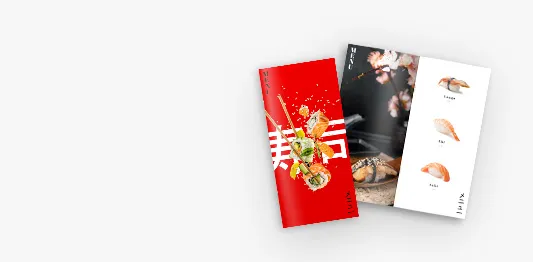
Dziękujemy za
założenie konta.
Twój prezent
już do Ciebie leci!
Sewn menu cards
Some product prices in cart have been updated according to the current discounts applicable for this account. Find the list of updated products below:

Dziękujemy za
założenie konta.
Twój prezent
już do Ciebie leci!
Some product prices in cart have been updated according to the current discounts applicable for this account. Find the list of updated products below:
Saddle-stitched menu cards are a unique type of catalogs. They usually have only a few pages, their main purpose being the transparent presentation of the menu offered by the restaurant, bar, pub, café or club. This applies both to elegant establishments and to regular concerns, such as the eateries you visit on a working day. Or when you need to boost your energy with a cup of coffee at a roadside bar while on holiday.
Regardless of the nature of the place, a saddle-stitched menu card must not include too many items. If it does, the restaurant may be unable to deliver products of appropriate quality, with its limited human resources and kitchen space. And customers are often confused with having too many options.

Menu cards serve both marketing and information purposes. They must provide information and be attractive enough to boost appetite and encourage customers to order. They should combine elements of a catalog, an advertising flyer, a prospectus and a brochure.
A short, properly printed menu is often believed to be the most important marketing element of a restaurant, other than the building itself. It can encourage customers who have planned to order one dish to order a few extra items. If they did not intend to have a dessert, they would change their mind and order once they see an appealing picture or a compelling description in the menu. A menu communicates the identity of an establishment and increases the income for the company.
If you need a menu-type catalog for your company, take care of the quality of the catalog printing. Pictures need to evoke emotions in the customers to encourage them to order certain products. Digital pictures are easily enhanced, and minor shortcomings can be eliminated. But catalog printing, that is the chemical process of giving data a physical form, requires high quality photographs. With them, the result is as required – delicious. You will achieve it with saddle-stitched menu cards printed by the Chroma online printing shop.

Pictures of meals must be adapted to the nature of the brand and the market segment in which it operates. For example, many customers associate large bright pictures next to dish descriptions with chain restaurants, fast foods and lower-class bars. Better establishments often have descriptions only. This way, they allow a customer who reads a saddle-stitched menu card to use their imagination.
This is not an ironclad rule, though. Sometimes top restaurant chains also have pictures in their menus. But if they do, the pictures are subtle and of top quality. A company who does not have such photos may consider artworks and illustrations. They tend to emphasize the nature of the place very well.
Colors of menu-type catalogs have the same function. Fresh and intense colors, like green, red or yellow, are suitable for a Mexican restaurant but not necessarily for an elegant evening club, which should opt for darker, silver or purple hues.

From a psychological point of view, customers use saddle-stitched menu cards not only to check what they feel like having and how much it costs. They also subconsciously compare products. People are unable to determine the absolute value of the complex product that is a restaurant dish. Its price includes the cost of the goods, the cook’s labor, lease of the premises, and electricity.
So when a restaurant guest is reading a menu-type catalog, they are evaluating particular dishes by subconsciously comparing them to one another – it is a type of simplified psychological reasoning. The most expensive items on the menu are rarely ordered, but they have an important role. They make the other ones look cheaper. In other words, expensive menu items anchor our perception at high prices.
The font to be chosen also depends on the number of items on a saddle-stitched menu card. The more text, the harder it is to arrange it on the page. If more than one font is used, the customer may find it easier to navigate the menu.
Boxes with certain dishes may also be convenient. They could group, for example, dishes made of similar ingredients or dishes with the highest margin.